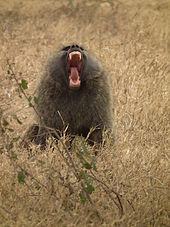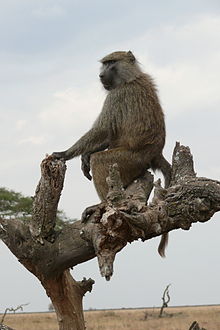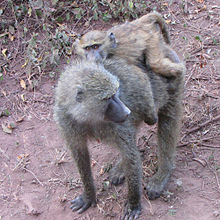- Olive baboon
-
Olive baboon[1] 
Conservation status Scientific classification Kingdom: Animalia Phylum: Chordata Class: Mammalia Order: Primates Family: Cercopithecidae Genus: Papio Species: P. anubis Binomial name Papio anubis
(Lesson, 1827)
Geographic range The olive baboon (Papio anubis), also called the Anubis baboon, is a member of the family Cercopithecidae (Old World monkeys). The species is the most widely spread of all baboons: it is found in 25 countries throughout Africa, extending south from Mali to Ethiopia and to Tanzania. Isolated populations are also found in some mountainous regions of the Sahara. It inhabits savannahs, steppes, and forests.
Contents
Physical characteristics
The olive baboon is named for its coat, which, at a distance, is a shade of green-grey.[3] (Its alternate name comes from the Egyptian god Anubis, who was often represented by a dog head resembling the dog-like muzzle of the baboon.) At closer range, its coat is multi-colored, due to rings of yellow-brown and black on the hairs.[4] The hair on the baboon's face, however, is finer and ranges from dark grey to black.[3] This coloration is shared by both sexes, although males have a mane of longer hair that tapers down to ordinary length along the back.[5] Besides the mane, the male olive baboon differs from the female in terms of size and weight; males are, on average, 70 cm tall and weigh 24 kg; females measure 60 cm and 14.7 kg.[5]
Like other baboons, the olive baboon has a long, pointed, dog-like muzzle.[5] In fact, along with the muzzle, the animal's tail (38–58 cm) and four-legged gait can make baboons seem very canine.[6] The tail almost looks as if it is broken, as it is held upright over the rump for the first quarter, after which it drops sharply.[3] The bare patch of a baboon's rump, famously seen in cartoons and movies, is a good deal smaller in the olive baboon.[5] The olive baboon, like most cercopithecines, has a cheek pouch with which to store food.[7]
Ecology
Range and habitat
The olive baboon inhabits a strip of 25 equatorial African countries, very nearly ranging from the east to west coast of the continent.[7] The exact boundaries of this strip are not clearly defined, as the species' territory overlaps with that of other baboon species.[3] In many places, this has resulted in cross-breeding between species.[3] For example, there has been considerable hybridization between the olive baboon and the Hamadryas baboon in Ethiopia.[6] Cross-breeding with the yellow baboon and the Guinea baboon has also been observed.[3] Although this has been noted, the hybrids have not yet been heavily studied.[3]
Throughout its wide range, the olive baboon can be found in a number of different habitats.[5] It is usually classified as savanna-dwelling, living in the wide plains of the grasslands.[8] The grasslands, especially those near open woodland, do make up a large part of its habitat, but the baboon also inhabits rainforests and deserts.[5] Uganda and the Democratic Republic of the Congo, for instance, both support olive baboon populations in dense tropical forests.[3]
Food habits
One major reason for its widespread success is that the olive baboon is not bound to a specific food source.[3] It is omnivorous, finding nutrition in almost any environment, able to adapt with different foraging tactics.[9] For instance, the olive baboon in grassland goes about finding food differently than one in a forest.[3] It is also worth noting that the baboon will forage on all levels of an environment: above and beneath the ground and in the canopy of forests.[9] Most animals will only look for food at one level; an arboreal species for instance, such as a lemur, will not look for food on the ground. The olive baboon will search as wide an area as it can, and it will eat virtually everything it finds.[9]
Virtually everything includes a large variety of plants, and invertebrates and small mammals as well as birds.[10] The olive baboon will eat leaves, grass, roots, bark, flowers, fruit, lichens, tubers, seeds, mushrooms, corms, and rhizomes.[10] Corms and rhizomes are especially important in times of drought, because grass loses a great deal of its nutritional value.[10] In dry, arid regions, such as the northeastern deserts, small invertebrates like insects, spiders, and scorpions fill out its diet.[10]
The olive baboon will also hunt prey, from small rodents and hares to foxes and other primates.[3] Its limit is usually small antelope, such as Thomson's Gazelle and also sometimes, sheep and goats, which accounts for 33% of its food from hunting.[3] Hunting is usually a group activity, with both males and females participating.[3] Interestingly, there is evidence that this systematic predation was developed recently. [11] In a field study, such behavior was observed as starting with the males of one troop and spreading through all ages and sexes.[11]
Observations suggest that in Eritrea the olive baboon has formed a symbiotic relationship with that country's endangered elephant population. The baboons use the water holes dug by the elephants, while the elephants use the tree-top baboons as an early warning system.[12]
Behaviour
Social structure
The olive baboon lives in groups of 15–150, made up of a few males, many females, and their young.[13] There is a complex social hierarchy similar to that found in other primates, such as gorillas and chimpanzees.[5] Each baboon has a social ranking somewhere in the group, depending on its dominance.[13] Female dominance is hereditary, with daughters having nearly the same rank as their mothers,[13][14] with adult females forming the core of the social system.[14] Mothers, daughters, grandmothers, aunts, and nieces associate with each other as a subgroup of the larger troop.[13] Related females are largely friendly to each other. They tend to stay close together and groom one another as well as support each other in agonistic encounters with other troop members, whether male or female.[14] With dominance, a females gains greater reproductive success, greater access to food and high-ranking supporters. A female will form a last-lasting social relationship with a male in her troop, known as a "friendship".[14] These friendships are sometimes formed when a sexually receptive female appoarches a newly immigrated male, and presents her swollen rumps or groom them to solicit mating.[13] The relationship will become long-lasting, if the males accepts, and the pair will groom and remain close to each other.[13] The males and females in these relationships spend time together in relaxed grooming sessions and will travel, forage, sleep and raise infants together as well as fight together against aggressive conspecifics.[14]
Males establish their dominance more forcefully then females.[13] A male will leave its natal group and joins another group after reaching sexual maturity.[13] They will try to bully other males and cow them into obedience.[13] Fights are not uncommon between males, and the loser will submit afterwards.[13] Because adult males within a group of olive baboons are not related, they often compete with each other, either directly or indirectly, for access to females.[14] Higher dominance means better access to mating and earlier access to food, so there is naturally a great deal of fighting over rank, with younger males constantly trying to rise in position.[3] Because females stay with their group their entire life, and males emigrate to others, there is often a new male challenging an older one for dominance.[13] Frequently, when older baboons drop in the social hierarchy, they will move to another tribe.[5] It has been observed that the younger males who pushed them down will often bully and harass the older.[5] Relationships between older males tend to be more relaxed, cooperative and egalitarian than those of younger males in their prime. The older males will form coalitions against the younger males and prevent them from gaining mating opportunities.[15] Older male olive baboons also form coalitions and will to prevent younger males from mating with estrous females.[13]
Reproduction and parenting
Females are sexually mature at 7–8 years, and males at 7–10 years.[5] The beginning of their ovulation is a signal to the males that she is ready. During ovulation, the skin of the female's anogenital area swells and turns a bright red/pink.[16] The swelling makes it difficult to move and increases the female's chance of infection or parasite.[16] Females with larger swellings reproduce at a younger age, produce a larger number of offspring per year, and a larger number of those offspring survive. Males are more attracted to females with larger swellings, contest mating more aggressively, and are likely to suffer from multiple followers and intruders during mating with females that have large swellings.[13] It also attracts males, who compete with each other to see who can mate with the female.[16] Mating among olive baboons is promiscuous; both males and females mate with multiple partners.[13] A male will form a mating consortship with an estrous female, staying close to and copulating with her.[17] These consortships can last from a few minutes to two weeks. The male will prevent other males from mating with his female.[18]
Infants are born with a black natal coat and bright pink skin. Females provide most of the care for infants but male may also take part.[13] Infants are dependent on their mothers for food and traveling for their first several months of life. For the first few days of life the the infant may have difficult time grasping on its mother and relies on her for physical support. However, its grasp will soon strengthen and is able to cling to its mother's fur by itself.[3] The infant begins to break contact with its mother and begin to explore their surroundings but only for some minutes and they are usually not far from their mothers. The distance that the infant spends away from its mother increases as it ages.[19] In general, higher-ranking females tend to be more "permissive" in their parenting than lower ranking females, who tend to me more "restrictive" and prevent their offspring from moving away from them.[5] Olive baboons do not seems to pratice cooperative caring of offspring, however it is not uncommon for a female to groom an infant that is not hers. Subadult and juvenile females are more likely to practice allomaternal behavior as they have not produced offspring of their own yet.[5] Adult males in the groups will also care for the infants are they are likely to be related to them.[20] Males groom infants, calm them when they are stressed and may decrease ectoparasitic loads.[20] However adult male will also exploit infants as the chance of being threatened by other males decreases when carrying in infant.[20]
 Yawning, Tanzania
Yawning, Tanzania
Communication
Olive baboons communicate with various vocalizations and facial expressions. Throughout the day, baboons of all ages emit the "basic grunt".[21] In addition, other calls given by adults include the "roargrunt", "cough-bark", and "cough geck". The latter two are made in response to unknown humans or low-flying birds, and the former is made by adult males after a fight.[21] A "wa-hoo" call is made in response to predators, neighboring groups at night and during stressful situations.[21] Other vocalizations include "broken grunting" (low volume, rapid series of grunts made during aggressive encounters of low intensity), "pant-grunts" (made when aggressive encounters intensify), "shrill barks" (loud, explosive calls given in alarm to sudden appearances of potential threats), and "screams" (high-pitched, continuous sounds in responding to intense emotion such as pain, fear, and aggression).[21] The most common facial expression of the olive baboon is "lipsmacking" which is made in a variety of social contexts including grooming and sexual behavior.[13] Lipsmacking as well as "tongue protrusion", "jaw-clapping", "ear flattening", "eyes narrowed", and "head shaking" are common greeting signals and are accompanied by a "rear present".[21] "Staring", "eyebrow raising", "yawning", and "molar grinding", are used to threaten other baboons.[13] A submissive baboon will respond with displays like the "rigid crouch", "tail erect", and "fear grin".[21]
Status
The olive baboon is listed as Least Concern by the IUCN because "this species is very widespread and abundant and although persecuted as a crop raider there are no major threats believed to be resulting in a range-wide population decline".[2] Despite vigorous trapping, shooting, and poisoning campaigns, the animal remains widespread and locally common.[2] However competition and disease have probably excluded baboons from closed forests in the long term.[2] It has been regarded as a pest species in some places and actively persecuted.[2]
References
- ^ Groves, C. (2005). Wilson, D. E., & Reeder, D. M, eds. ed. Mammal Species of the World (3rd ed.). Baltimore: Johns Hopkins University Press. pp. 166. OCLC 62265494. ISBN 0-801-88221-4. http://www.bucknell.edu/msw3/browse.asp?id=12100581.
- ^ a b c d e Kingdon, J., Butynski, T. M. & De Jong, Y. (2008). Papio anubis. In: IUCN 2008. IUCN Red List of Threatened Species. Downloaded on 4 January 2009.
- ^ a b c d e f g h i j k l m n o Cawthon Lang, KA (2006-04-18). "Primate Factsheets: Olive baboon (Papio anubis) Taxonomy, Morphology, & Ecology". http://pin.primate.wisc.edu/factsheets/entry/olive_baboon/taxon. Retrieved 2007-01-27.
- ^ Rowe N. 1996. The pictorial guide to the living primates. East Hampton (NY): Pogonias Pr.
- ^ a b c d e f g h i j k l Shefferly, N. (2004). "Papio anubis". Animal Diversity Web accessdate = 2007-01-27. http://animaldiversity.ummz.umich.edu/site/accounts/information/Papio_anubis.html.
- ^ a b Nagel U. (1973) "A comparison of anubis baboons, hamadryas baboons and their hybrids at a species border in Ethiopia". Folia Primatol 19: 104-65.
- ^ a b Groves C. (2001) Primate taxonomy. Washington DC : Smithsonian Inst Pr.
- ^ Rowell TE. (1966) "Forest living baboons in Uganda". J Zool 149: 344-65.
- ^ a b c Whiten A, Byrne RW, Barton RA, Waterman PG, Henzi SP. (1991) "Dietary and foraging strategies of baboons". Phil Trans R Soc Lond 334(1270): 187-97.
- ^ a b c d Skelton, S.. "Savanna Baboon (Papio cynocephalusd)". http://wanp.exis.net/~spook/babtxt.hml. Retrieved 2007-01-29.
- ^ a b Strum, S C. (1975). "Primate Predation: Interim Report on the Development of a Tradition in a Troop of Olive Baboons". Science 187 (4178): 4178. doi:10.1126/science.187.4178.755. PMID 17795248.
- ^ "The rediscovery of Eritrea's elephants". BBC Wildlife magazine. July 2003. Archived from the original on 2006-03-14. http://web.archive.org/web/20060314104912/http://www.bbc.co.uk/nature/animals/features/300feature1.shtml. Retrieved 2007-09-28.
- ^ a b c d e f g h i j k l m n o p q Cawthon Lang, KA (2006-04-18). "Primate Factsheets: Olive baboon (Papio anubis) Behavior". http://pin.primate.wisc.edu/factsheets/entry/olive_baboon/behav. Retrieved 2007-01-27.
- ^ a b c d e f Smuts, Barbara (1985). Sex and Friendship in Baboons. New York: Aldine Publications. ISBN 978-0-202-02027-3. http://books.google.com/?id=Vx_l76muFWMC&printsec=frontcover&dq=smuts+%22Sex+and+Friendship+in+Baboons%22&q. Retrieved 28 April 2010
- ^ Smuts BB, Watanabe JM. (1990) "Social relationships and ritualized greetings in adult male baboons (Papio cynocephalus anubis) ". Int J Primatol 11(2): 147-72.
- ^ a b c Motluk, Alison (2001). "Big Bottom". New Scientist 19 (07).
- ^ Packer C. (1979). "Inter-troop transfer and inbreeding avoidance in Papio anubis". Anim Behav 27(1): 1-36.
- ^ Bercovitch FB. (1991) "Mate selection, consortship formation, and reproductive tactics in adult female savanna baboons". Primates 32(4): 437-52.
- ^ Nash LT. (1978) "The development of the mother-infant relationship in wild baboons (Papio anubis)". Anim Behav 26(3): 746-59.
- ^ a b c Packer C. (1980) "Male care and exploitation of infants in Papio anubis". Anim Behav 28: 512-20.
- ^ a b c d e f Ransom TW. (1981) Beach troop of the Gombe. East Brunswick (NJ): Assoc Univ Pr. 319 p.
Categories:- IUCN Red List least concern species
- Cercopithecine monkeys
- Fauna of Burkina Faso
- Mammals of Ethiopia
- Fauna of Mali
- Fauna of the Sahara
- Fauna of Tanzania
- Fauna of West Africa
- Mammals of Africa
- Megafauna of Africa
- Animals described in 1827
Wikimedia Foundation. 2010.








